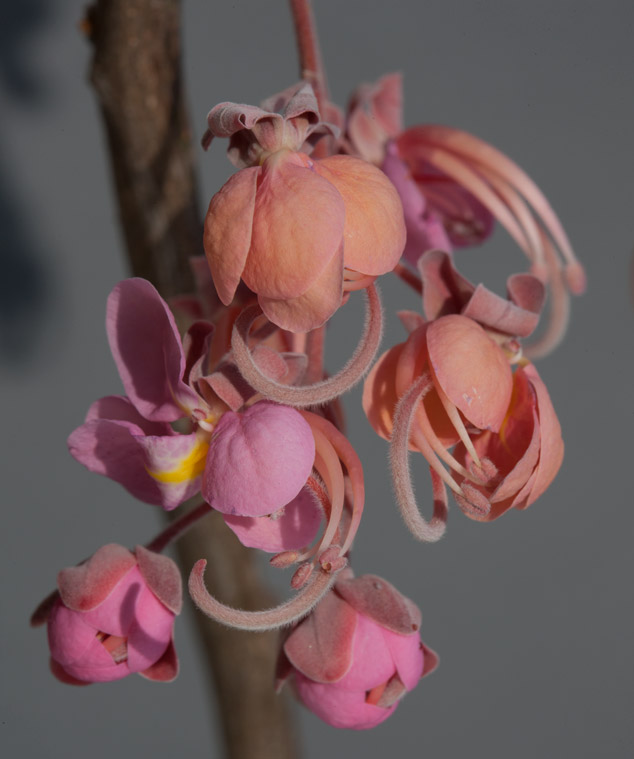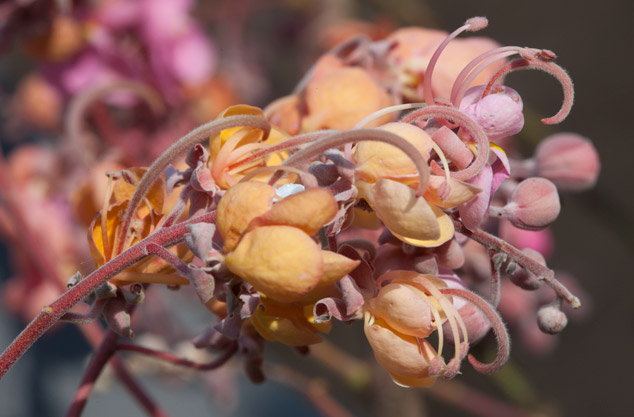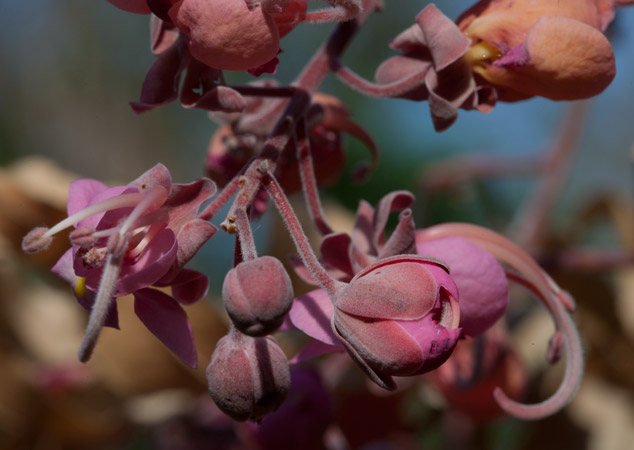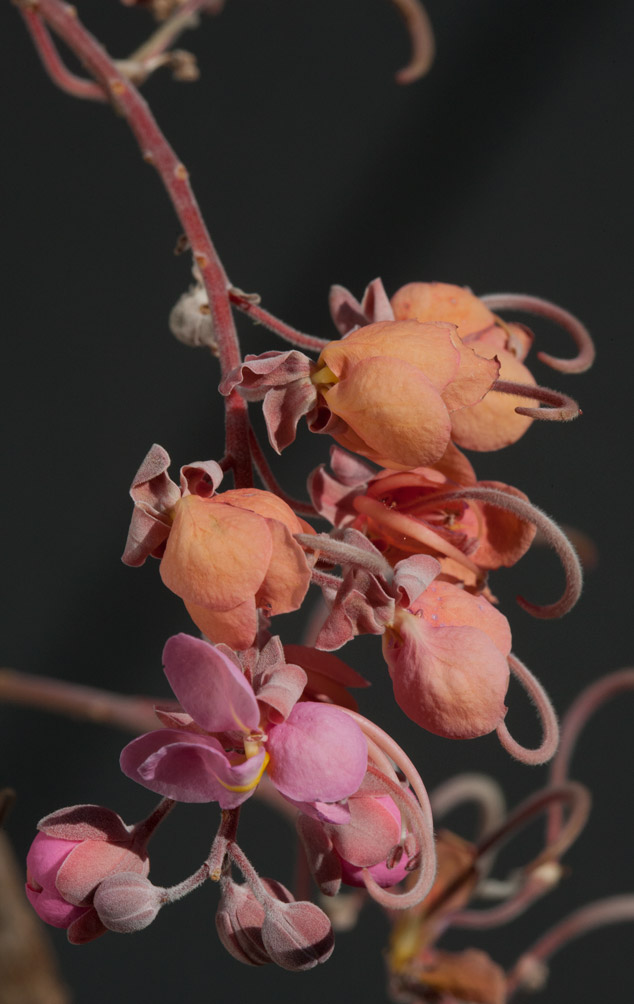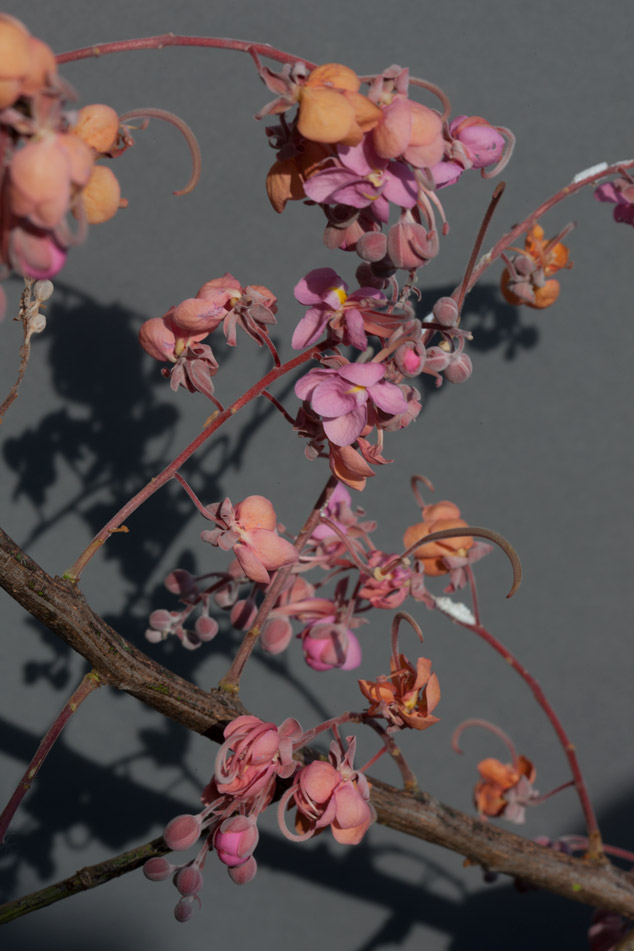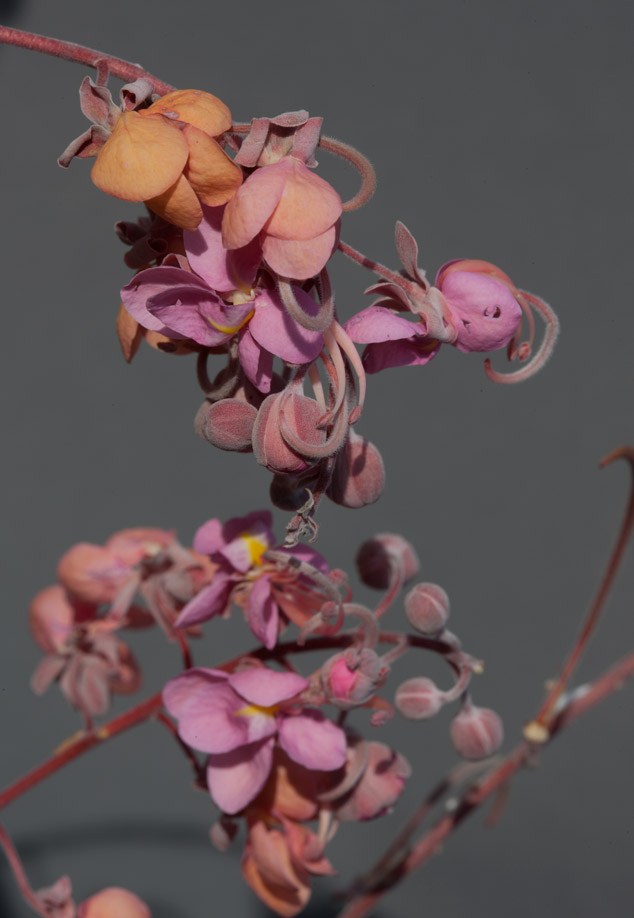Two species of Cassia in Guatemala
Cassia grandis is native, and has pink flowers.
Cassia fistula is from Asia, and has yellow flowers.
These trees flowers from January, February, March, April, May.
Cassia grandis or carao flower cacao flavor.
The Cassia grandis is known as bucut, carague, carao, mucut, or Pink Shower Tree. This is not cañafístola or cañafístula. That is Cassia fistula and is from Asia. The pre-Columbian species is Cassia grandis. However because the seed pod is similar in both species, the native tree in Mesoamerica is also called cañafístola or cañafístula.
Uses of Cassia grandis, bucut
The informative book by OFI-CATIE gives a general statement on use of Cassia grandis.
Cassia grandis or carao flower cacao flavor, Río los Esclavos, Santa Rosa.
En Centroamérica, especialmente Costa Rica, la pulpa azucarada color café que rodea las semillas se usa como substituto del chocolate y los mayas lo usaban para endulzar bebidas. La pulpa es dulce pero maloliente. En Nicaragua se cuece con leche y en Choluteca, Honduras y en El Salvador se hacen frescos. Sin embargo, parece tener propiedades laxantes, depurativas y estimulantes, por lo que su uso es limitado. En Guatemala se venden en los mercados en Petén para medicina casera. También se venden en los mercados y tiendas de El Salvador por su pulpa comestible, que generalmente se prepara en bebidas. (Cordero and Boshier 2003: 439.
Cassia grandis or carao flower cacao flavor.
Also used as a living fence.
In general, documentation of the use of such trees is inadequate. Generally everyone quotes on source. And 90% of the web sites simply copy-and-paste and do not cite where they are taking the info from. But even without scholarly citations it still helps to have information, such as the following:
Cassia grandis or carao flower cacao flavor, Río los Esclavos, Santa Rosa.
Iron Magazine recently reported that: “It's known as Cassia Grandis and has been an effective natural remedy for anaemia. But it also has an interesting side effect in many men. It reportedly spurs spontaneous libido. Could this be due to a lowering of SHBG? At this point, it would only be speculative to say. One would think that something that cured anaemia would be high in iron but tests on Carao extract reveal almost no iron. This one is a big question mark. It could be nothing more than the impoverished people were anaemic before taking it and once cured, felt completely revitalized, yet among athletes who have tried it, the consensus is that it definitely improves endurance.” (www.belize.com/articles/flora/cassia-grandis-bukut-tree.html#ixzz1xAQfSVD3)
Cassia grandis or carao flower cacao flavor.
Location of Cassia grandis in Guatemala.
Cassia grandis can be seen at Parque Nacional Tikal, near the aguada next to the sculpture museum. There is a nice sign at the base of the tree clearly identifying it.
Cassia grandis or carao flower cacao flavor.
Botanical books indicate that this tree grows in most of the departamentos of Guatemala below 1000 meters elevation, so more than half the country. We found it in a garden near the Rio de los Esclavos, one hour drive from Guatemala City. Blooming in mid-March.
Cassia grandis or carao flower cacao flavor.
Cassia grandis or carao flower cacao flavor.
Introductory Bibliography on Cassia grandis
- 2003
- Árboles de Centroamérica: un Manual para Extensionistas (Trees of Central America: a Manual for Extentionists), OFI-CATIE, pages 439-442.
- 1991
- Plants used in Guatemala for the treatment of dermatophytic infections. 1. Screening for antimycotic activity of 44 plant extracts. J Ethnopharmacol. 1991 Mar; 31(3):263-76.
- 1990
- Mexican Market Plants of 16th Century. I. Plants recorded in Historia Natural de Nueva Espana. J. Ethnobio. 10(2):151-168. Winter 1990.
- 2006
- Aspectos floristicos de Lacanja Chansayab, Selva Lacandona, Chiapas. Acta Botanica Mexicana, Octobre, numero 077, pp. 69-98. Instituto de Ecologia A.C., Patzcuaro, Mexico.
- 1968
- Arboles tropicales de Mexico. Instituto Nacional de Investigaciones Forestales, Mexico, D.F.
- 2005
- Arboles tropicales de Mexico: Manual para la identification de las principales especies. 3rd edition. Universidad Nacional Autónoma de México, Mexico D.F.
Faculty of Chemical Sciences and Pharmacy, University of San Carlos, Guatemala.
Bibliography: Web sites
www.belize.com/articles/flora/cassia-grandis-bukut-tree.html
posted March 12, 2013.




